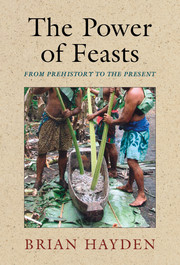Book contents
- Frontmatter
- Contents
- List of Figures
- Acknowledgments
- 1 Before the Feast
- 2 Food Sharing and the Primate Origins of Feasting
- 3 Simple Hunter/Gatherers
- 4 Transegalitarian Hunter/Gatherers
- 5 Domesticating Plants and Animals for Feasts
- 6 The Horticultural Explosion
- 7 Chiefs Up the Ante
- 8 Feasting in Early States and Empires
- 9 Industrial Feasting
- References Cited
- Index
1 - Before the Feast
Initial Considerations
Published online by Cambridge University Press: 05 October 2014
- Frontmatter
- Contents
- List of Figures
- Acknowledgments
- 1 Before the Feast
- 2 Food Sharing and the Primate Origins of Feasting
- 3 Simple Hunter/Gatherers
- 4 Transegalitarian Hunter/Gatherers
- 5 Domesticating Plants and Animals for Feasts
- 6 The Horticultural Explosion
- 7 Chiefs Up the Ante
- 8 Feasting in Early States and Empires
- 9 Industrial Feasting
- References Cited
- Index
Summary
At the heart of science is an essential balance between two seemingly contradictory attitudes – an openness to new ideas, no matter how bizarre or counterintuitive, and the most ruthlessly skeptical scrutiny of all ideas, old and new.
– Carl Sagan, The Demon Haunted WorldWHY STUDY FEASTS?
“Feasts.” The word conjures up images of sybaritic self-indulgence or luxurious, lavish opulence and frivolity. In Industrial cultures, feasts are generally fun events that satiate our gustatory and social senses. They seem to have little practical benefit. They provide experiences outside our work and the drudgery of daily responsibilities (Figure 1.1). Feasts have undoubtedly always had such appeal. However, what you will discover in this book is that feasting in pre-Industrial societies had, and still has, far-reaching consequences in many other domains (Figure 1.2). In fact, up until the Industrial Revolution, there may have been no other more powerful engine of cultural change than feasts.
This book provides an initial synthesis of what archaeologists, ethnoarchaeologists, ethnographers, and historians know about the dynamics of feasting in pre-Industrial societies. Although ethnographers and historians have a long tradition of documenting feasts, sometimes in minute detail, they have not always been very diligent in probing the inner dynamics and benefits that are associated with feasts or in examining feasts from broader theoretical perspectives. Early colonial government administrators and missionaries were generally baffled by the enormous quantities of food and valuable gifts that seemed to be squandered at large tribal feasts. This behavior seemed antithetical to economic progress and particularly to company profits or government revenues. Governments often reacted by outlawing traditional feasts like the potlatch of the Northwest Coast of North America and the major feasts in Indonesia and Vietnam.
Information
- Type
- Chapter
- Information
- The Power of FeastsFrom Prehistory to the Present, pp. 1 - 24Publisher: Cambridge University PressPrint publication year: 2014
